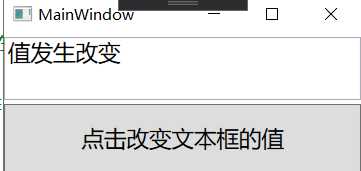WPF/MVVM模式入门教程(二):实现INotifyPropertyChanged接口
2021-03-11 20:27
标签:date org mes model vim ble this 技术 消息通知 我们在common文件夹下创建一个名为NotifyPropertyChanged.cs的类,该类继承INotifyPropertyChanged接口主要用于消息通知,当UI里的值发生改变的时候,能够触发相应的改变。 在Model文件夹下面创建一个FModel.cs,该类为数据模型,存放的是数据的字段。 在ViewModel文件夹下创建FViewModel.cs,该类为MVVM里最为重要的VM,主要是执行你的后台业务逻辑。 需要注意的是,VM要继承第一步创建的NotifyPropertyChanged,只有继承之后才能使用RaisePropertyChanged()方法 下面的代码是View的页面代码,其中的TextBox控件的Text绑定了Name字段,当Name字段发生改变的时候,该控件显示的内容也将会改变。 在第四步的时候我们定义了页面,但是此时View还没有和ViewModel和Model联系起来,因此我们需要在该View的后代代码(F.xaml.cs)里加入一些东西 其中的this.DataContext = f;是将Vime和ViewModel联系在了一起,然后我们通过一个按钮点击事件改变Name的值,看看页面的效果是否发生改变。之前说过了,使用MVVM模式的目的就是为了使项目高内聚低耦合,理想状态View的后台代码是不能写按钮点击事件的,但现在只是临时的,下一章将会讲到通过命令的手段实现按钮点击事件,实现低耦合的目标。 WPF/MVVM模式入门教程(二):实现INotifyPropertyChanged接口 标签:date org mes model vim ble this 技术 消息通知 原文地址:https://www.cnblogs.com/flh1/p/12447188.html1.创建NotifyPropertyChanged类
using System;
using System.Collections.Generic;
using System.ComponentModel;
using System.Linq;
using System.Text;
using System.Threading.Tasks;
namespace MVVMtest1.common
{
public class NotifyPropertyChanged : INotifyPropertyChanged
{
///
2.创建Model
using System;
using System.Collections.Generic;
using System.Linq;
using System.Text;
using System.Threading.Tasks;
namespace MVVMtest1.Model
{
public class FModel
{
public string Name { get; set; }
}
}
3.创建ViewModel
using System;
using System.Collections.Generic;
using System.Linq;
using System.Text;
using System.Threading.Tasks;
using MVVMtest1.common;
using MVVMtest1.Model;
namespace MVVMtest1.ViewModel
{
public class FViewModel: NotifyPropertyChanged
{
FModel fModel;//View跟Model中间隔着VM,所以要在VM里实例化Model
public FViewModel() //构造函数
{
fModel = new FModel() { Name="易羽晨"};
}
public string Name
{
get { return fModel.Name; }
set
{
if (fModel.Name!=value)
{
fModel.Name = value;
RaisePropertyChanged("Name");//当字段改变时就通知
}
}
}
}
}
4.View的xaml代码
5.View的后台代码
using System;
using System.Collections.Generic;
using System.Linq;
using System.Text;
using System.Threading.Tasks;
using System.Windows;
using System.Windows.Controls;
using System.Windows.Data;
using System.Windows.Documents;
using System.Windows.Input;
using System.Windows.Media;
using System.Windows.Media.Imaging;
using System.Windows.Navigation;
using System.Windows.Shapes;
using MVVMtest1.ViewModel;
namespace MVVMtest1
{
///
6.运行效果
点击按钮前

点击按钮后

可以看到,我们已经实现了通过NotifyPropertyChanged接口实现了消息的传递,以及UI的更改。下一章将会讲关于命令的内容。
文章标题:WPF/MVVM模式入门教程(二):实现INotifyPropertyChanged接口
文章链接:http://soscw.com/index.php/essay/63352.html